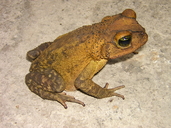|
Description
This species is a member of the Bufo peltocephalus group. These toads are usually dark brown dorsally, with pale yellow to cream markings that vary from small, discrete spots to irregular vermiculations. The limbs are similarly spotted. The venter is dull gray. The dorsum is tuberculate, with the tubercles low and rounded (not spinose). The throat, chest and large paratoid glands are instead spinose. Juveniles differ from adults: the dorsum is tan and marked by a dark brown interocular triangle and two pairs of dark blotches. The adult cranial crests are high and lack an anterorbital notch at the junction of the supraorbital and canthal crests. The upper jaw is distinctly flanged. The head profile is distinctly more sharp-nosed than blunt. Adults are large, averaging 147 mm in females and 138 mm in males.
The tadpoles, by stage 20, have a dark brown dorsum and a yellowish venter. In stage 25 they are dark brown with small spots and a pale band in the middle of the body. In stages 30-36 they are greenish-cream dorsally with dark brown spots, and the pale band is restricted to the posterior half of body. The sides of the body are also spotted, and the caudal musculature is pale. Tadpoles reach their greatest size (24 mm) in stage 36. They have ventrally disposed, subterminal mouths. A row of papules emarginate the lateral borders of the oral disc; the dental formula is 2(2)/3. The spiracle is sinistral (Schwartz 1960; Ruiz 1987; Schwartz and Henderson 1985;Schwartz and Henderson 1991; Diaz et al. 2000).
Distribution and Habitat
Country distribution from AmphibiaWeb's database: Cuba
This species is endemic to Cuba and it is found in Central and Eastern Cuba, from sea level to mountain areas (about 800 m). It is found in mesic broadleaf forests, cultivated fields, along stream banks and around rural houses.Life History, Abundance, Activity, and Special Behaviors
Bufo taladai is a nocturnal toad, taking refuge by day under rocks, under palm trash and in cavities they excavate. It is able to inflate itself to prevent ingestion by predators. Males vocalize from the ground, from small rocks and many times from the water among herbaceous vegetation. They form choruses in shallow creeks, flooded ditches, ponds and mountain streams. Calls consist of periodic notes containing four or seven amplitude modulations. The dominant frequency is around 0.7-0.8 kHz. These calls are loud, like a machine gun (“rroco-rroco-rroco”). Breeding males have nuptial excrescences on their thumbs. The amplexus is axillary. The eggs are laid in strings that are fastened to the roots of herbaceous vegetation on water banks of 5-10 cm in depth. Embryos are disposed side by side in the strings. The tadpoles eat co-specific larvae and small fish (Girardinus sp.). Food of adults includes Formicidae (Solenopsis sp. and other), Acarina, Orthoptera, Coleoptera, Heteroptera, Opiliones (Cynorta sp.) and scorpions (Centruroides anchorellus). Grits and plant material is presumably also consumed, though incidentally. This species is parasitized by tapeworms (Batrachotaenia bufonis) and nematodes (Aplectana hamatospicula, Oswaldocruzia lenteixeirai, Rhabdias elegans, Porrocaecum sp.). It can hybridize with Bufo peltocephalus (Schwartz 1960, Coy and Lorenzo 1982, Ruiz 1987, Schwartz and Henderson 1991, Díaz et al. 2000, Fong and Garcés 2002, Alonso and Rodríguez 2003). Trends and Threats
Some natural areas in Eastern Cuba have been degraded and substituted by coffee or timber plantations, or even by pastures, inducing the extinction of this species within its original habitat (Fong 1999).
Possible reasons for amphibian decline General habitat alteration and loss
Intensified agriculture or grazing
Comments
Synonyms- Peltaphryne taladai (Schwartz, 1960)
Etymology- Named in honor of James R. Taladai, who greatly assisted the author in the field (Schwartz 1960)
Related species- B. peltocephalus, B. fustiger
References
Alonso, R., and Rodríguez, A. (2003). ''Advertisement calls of Cuban toads of the genus Bufo (Anura, Bufonidae).'' Phyllomedusa, 2(2), 75-82.
Coy, A., and Lorenzo, N. (1982). ''Lista de los helmintos parásitos de los vertebrados silvestres cubanos.'' Poeyana, 235, 1-57.
Diaz, L.M., Moreno, L.V., and Begue, G. (2000). ''Descripción de las larvas de Bufo taladai (Anura: Bufonidae).'' Caribbean Journal of Science, 36, 1-2.
Fong, A. (1999). ''Changes in amphibian composition in altered habitats in eastern Cuba.'' Froglog, 36, 2.
Fong, A., and Garcés, G. (2002). ''Bufo taladai (NCN). Diet.'' Herpetological Review, 33(4), 302.
Ruiz, F. N. (1987). Anfibios de Cuba. Cientifíco-Técnica, La Habana.
Schwartz, A . and Henderson, R. W. (1985). A Guide to the Identification of the Amphibians and Reptiles of the West Indies Exclusive of Hispaniola. Milwaukee Public Museum, Milwaukee.
Schwartz, A. (1960). ''The large toads of Cuba.'' Proceedings of the Biological Society of Washington, 73, 45-56.
Schwartz, A. and Henderson, R. W. (1991). Amphibians and Reptiles of the West Indies: Descriptions, Distributions and Natural History. University Press of Florida, Florida.
Valdés, A. (1989). ''Systematics comments on Peltophryne peltocephala (Anura: Bufonidae) in the Cuban Archipelago.'' Caribbean Journal of Science, 24(1-2), 39-43.
Originally submitted by: Ansel Fong G. (first posted 2004-11-10)
Edited by: Anisha Gandhi (2008-02-03)Species Account Citation: AmphibiaWeb 2008 Peltophryne taladai: Cuban Spotted Toad <https://amphibiaweb.org/species/407> University of California, Berkeley, CA, USA. Accessed May 24, 2025.
Feedback or comments about this page.
Citation: AmphibiaWeb. 2025. <https://amphibiaweb.org> University of California, Berkeley, CA, USA. Accessed 24 May 2025.
AmphibiaWeb's policy on data use.
|
